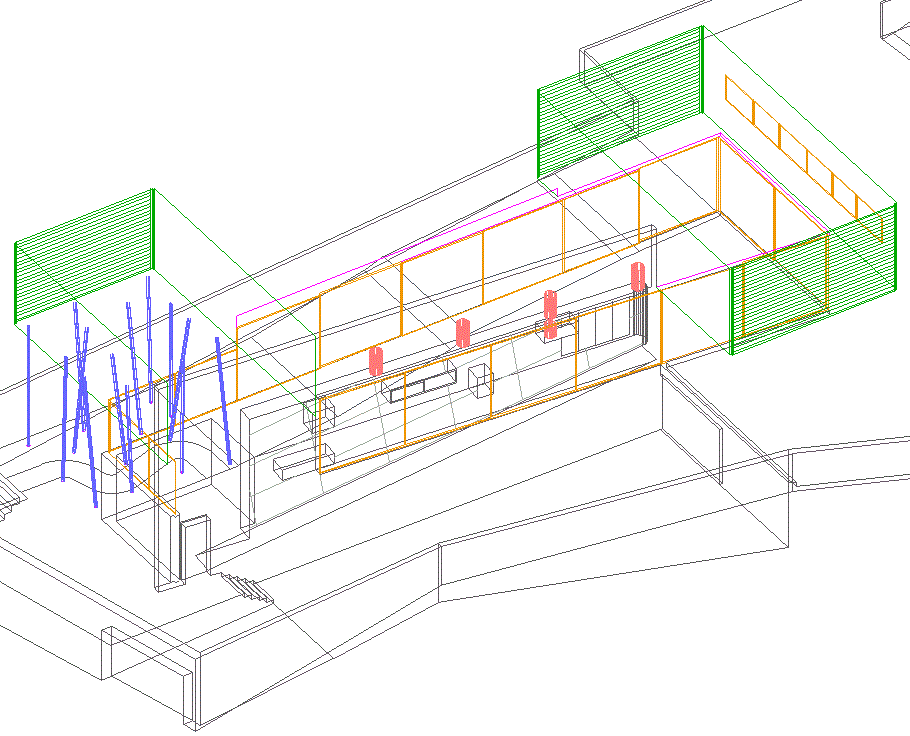2008.02.10 11:41
Archinect's The Plagiarius Awards Gallery
It's funny, I never imagined the clarifying of a situation as a form of punishment. Then again, it has often been said that "the [impact of] truth hurts."
3333y
2008.02.10 11:24
Archinect's The Plagiarius Awards Gallery
Again, architectural design inspiration often manifests a form of reenactment.
If a student acknowledges their inspirational source, then there is no plagiarism involved.
Reenactment is a(n often utilized yet unacknowledged) powerful learning tool.
3333y

New House 4 Casanova
3333y
| |
Unlike Paul Rudolph, for whom every formal gesture is a hedonistic wink at the spectator, Stirling has revealed the possibilities of an endless manipulation of the grammar and syntax of the architectural sign. He employs with extreme coherence the formalistic laws of contrast and opposition of his language's elements: the rotation of the axes, the use of antithetic materials, and technological distortions.4 The result of such controlled bricolage is a metaphorical reference to something very dear to the English architect: the architecture of ships. "A dream with marine references"5 is the way Kenneth Frampton has accurately labeled the Leicester University Engineering Laboratory (fig. 3), a true iceberg sailing in the sea of the park into which it is casually set down,
following an enigmatic course. Yet insofar as Stirling does not appreciate such "fishing for references," the porthole, which ironically comes up from the base of the laboratories at Leicester (next to the jutting Melnikovian halls), seems to confirm that constructivist poetics are a primary source--an almost too obvious reference to the design for the Palace of the Soviets (1923) by the Vesnin brothers (fig. 4). Yet the theme of the ship comes back, this time with proper literary references, in the terracing, the general organization and the common access ways of the Andrew Melville Hall at St. Andrews University (fig. 7). Again, it is Frampton who notes that here the marine metaphor takes on a more precise meaning: the ship, like the phalanstery, symbolizes an unattainable community will.6 The ship, the monastery and the phalanstery are thereby equivalent. From a desire to achieve perfect communal integration, they isolate themselves from the world. Le Corbusier and Stirling themselves appear, at La Tourette and St. Andrews, to pronounce a painful discovery: social utopianism can only be discussed as a literary document and can only come into architecture as a linguistic element, or better, as a pretext for the use of language.
The charged atmosphere of the young rebels of the 1950s and of the Independent Group, of which Stirling was a member between 1952 and 1956, has thus a coherent result. The affirmation of language, here understood as an interweaving of complex syntactic valences and ambiguous semantic references, also includes the "function," the existential dimensions of the work. Yet it only deals with a "virtual function" and not an effective function. The Andrew Melville Hall represents theatrically the space of communal integration which--from the time of the Spangen block (1921) of Michael Brinkman (fig. 6) to the housing commune (1927) of Moses Ginsburg (fig. 8), the postwar plans of Le Corbusier and Alison and Peter Smithson, and the building of Park Hill and Robin Hood Gardens7--the orthodoxy of the Modern movement had hoped to make operable as spaces of social precipitation
Suspending the public destined to use his buildings in a limbo of a space that ambiguously oscillates between the emptiness of form and a "discourse on function"--that is, architecture as an autonomous machine, as it is spelled out in the History building at Cambridge (fig. 5) and made explicit in the project for Siemens AG (fig. 9)--Stirling carries out the most cruel of acts by abandoning the sacred precinct in which the semantic universe of the modern tradition has been enclosed. Neither attracted nor repulsed by the independent articulation of Stirling's formal machines, the observer is forced in spite of himself to recognize that this architecture does indeed speak its own language, one that is perversely closed into itself. It is possible only to sink or swim, forced into a swinging course, itself just as oscillating as the perverse play of the architect with the elements of his own language.
| |

20011601
|

